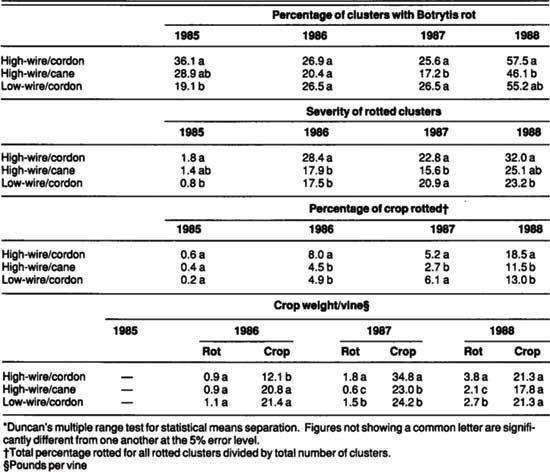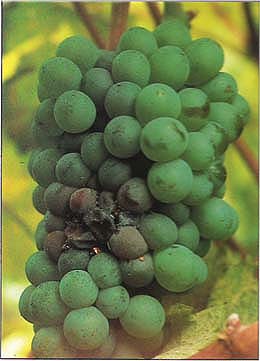All Issues
Grape pruning methods can affect Botrytis bunch rot
Publication Information
California Agriculture 44(3):9-10.
Published May 01, 1990
PDF | Citation | Permissions
Abstract
The vineyard training/pruning system can dramatically influence the amount of Botrytis bunch rot. Trying to achieve better light reception can impede air movement and result in greater incidence of rot.
Full text
Researchers recently concluded that growers can manage a vine's microclimate to reduce the development of Botrytis bunch rot in vineyards by increasing the air movement around clusters. Differences in Botrytis severity were further noted during a study of different trellis heights and different training and pruning methods in a Santa Maria white riesling vineyard.
Previous data had focused on vine yield and fruit composition parameters. In 1985 the study was expanded to include the incidence of Botrytis bunch rot among the differently established vines.
Methods
The trial, established in 1982, consisted of three treatments (fig. 1): a low spur-pruned bilateral cordon at 36 inches with two kicker canes wrapped onto a wire 46 inches high; a high-cordon at 55 inches with no upper foliage support wires; and a high, headtrained, cane-pruned treatment at 55 inches, also without any additional upper wire. Treatments were replicated five times using five-vine plots in a completely randomized design.
Insufficient air circulation can promote Botrytis bunch rot in grapes. Proper pruning keeps the fruit bunches clear of enveloping leaves.
Fig. 1. Three training/pruning alternatives for grapevine (left: pruned vine on trellis; right: cross-section of bearing vine).
Each winter from 1982 through 1988, every vine was pruned to 70 buds. During the harvests of 1985-88, we scored the three middle vines of each five-vine plot for rot percentage and severity. Each cluster was harvested and individually assessed for presence or absence of rot, and the rot percentage was determined for each rotted cluster. Finally, harvest weights were taken for each plot in 1986, 1987, and 1988 to determine the percentage rot of the crop by weight.
Results
It was hypothesized that the 55-inch vine training systems would place the vine canopy higher into the prevailing wind, resulting in better air mixing, less humidity, and less Botrytis bunch rot. However, the vines trained as high-wire cordons generally had significantly more rot than either the highwire cane or low-wire cordon systems.
Rot severity was significantly greater in the high-wire cordon vines than in the high-wire cane vines for 2 out of 4 years, and significantly greater than the low-wire vines for 3 out of 4 years (table 1). In most years, the high-wire cane system tended to have fewer rotted clusters, although only in 1987 was the difference significant.
In cross-section (fig. 1), you can see that a vine grown on the high-wire cordon system places the clusters in the middle of an enveloping canopy of foliage. In contrast, the clusters of vines grown on the high-wire cane and low-wire cordon systems actually fall away from and below most of the foliage, theoretically allowing better air movement around the clusters.
Conclusions
Attempts to increase sunlight penetration by growing grapevines on a high-wire, bilateral cordon, spur-pruned system actually harmed the crop by increasing the incidence of Botrytis bunch rot. Based on these results, a high-wire system should only be used either in conjunction with cane pruning or, possibly, with an additional foliage catch wire that will prevent the development of an enveloping foliage canopy that could foster Botrytis bunch rot.
Acknowledgements
The authors gratefully acknowledge the assistance and cooperation of Sierra Madre Vineyards, Dale Hampton, and Lon Fletcher.







